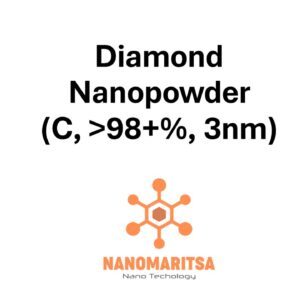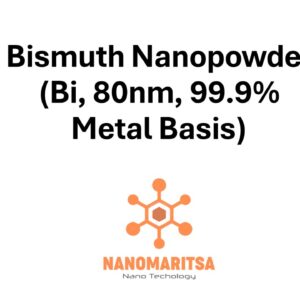Aluminum Nanopowder (Al, 99.9%, 40 nm, metal basis) is a highly refined form of aluminum in the nanoparticle range, with a particle size of 40 nanometers (nm). This nanopowder retains many of aluminum’s beneficial properties, such as high conductivity, light weight, and reactivity, while exhibiting the unique characteristics of nanoparticles, such as enhanced surface area and chemical reactivity. Here’s a detailed breakdown:
1. Key Features:
- Aluminum (Al): The nanopowder is made of aluminum, a lightweight metal known for its excellent electrical conductivity, thermal conductivity, and corrosion resistance. Aluminum is also highly abundant and widely used in industries like aerospace, automotive, and manufacturing.
- Purity (99.9%): With a 99.9% purity, this nanopowder has minimal impurities, ensuring high quality and optimal performance in applications where purity is critical.
- Nanoparticle Size (40 nm): The nanoparticles have an average size of 40 nm, which ensures a high surface area for increased reactivity. This size allows the powder to exhibit distinctive properties, such as higher chemical reactivity, better dispersion, and more efficient material interaction compared to larger aluminum particles.
- Metal Basis: The metal basis refers to the actual aluminum content of the nanopowder. It ensures that 99.9% of the powder is composed of pure aluminum, ensuring excellent material properties and performance.
2. Properties:
- Surface Area and Reactivity: With a 40 nm size, the nanopowder has a large surface area relative to its volume, which increases its reactivity. This makes it ideal for applications requiring fast chemical reactions or high surface interaction.
- High Conductivity: Aluminum is known for its high electrical and thermal conductivity, which is retained in the nanopowder form. This makes it useful for applications that require efficient energy transfer or heat dissipation.
- Lightweight: As a metal, aluminum is inherently lightweight, and this property remains in the nanopowder. This can be particularly beneficial in applications where lightweight materials are required, such as in aerospace and automotive industries.
- Oxidation Resistance: Aluminum is naturally resistant to corrosion due to the formation of a protective oxide layer on its surface. However, the increased surface area of nanoparticles may make them more prone to oxidation if not handled or stored properly.
3. Applications:
- Energy Storage: The high surface area and reactivity of the nanopowder make it useful in batteries, especially in lithium-ion batteries or other energy storage systems, where it can act as a component to increase capacity or enhance charge/discharge cycles.
- Aerospace and Automotive Industries: The lightweight nature of aluminum nanoparticles makes them valuable in applications within aerospace and automotive industries, where reduced weight can improve fuel efficiency and performance. Aluminum nanopowder can be used in lightweight composite materials, coatings, or as an additive in lubricants.
- Catalysis: Due to the high surface area and reactivity of aluminum nanoparticles, they can be used in catalysis for various chemical reactions, such as in fuel production, chemical synthesis, or environmental processes like pollutant removal.
- Additive Manufacturing: Aluminum nanopowder is used in 3D printing and additive manufacturing, particularly for metal-based 3D printing where the properties of aluminum can be harnessed for the production of lightweight and durable components.
- Coatings and Surface Treatments: Aluminum nanopowder can be incorporated into coatings to enhance properties like corrosion resistance and durability. It is also used in paints and anti-corrosion treatments.
- Pyrotechnics and Explosives: Due to its high reactivity, aluminum nanopowder is sometimes used in pyrotechnics and explosives as a fuel component in combustion reactions.
4. Handling and Safety:
- Health and Safety Considerations: As with all nanopowders, special care should be taken when handling aluminum nanopowder. Nanoparticles can pose health risks if inhaled or ingested, leading to respiratory issues or other health concerns. Proper personal protective equipment (PPE), such as gloves, goggles, and respirators, should be worn when handling this material.
- Storage: The nanopowder should be stored in a cool, dry, and well-ventilated environment to prevent oxidation and to maintain its effectiveness. The material should be kept in sealed containers to avoid exposure to moisture and air, which could cause the formation of an oxide layer or aggregation of particles.
- Precautions: The powdered form can easily become airborne, so it is recommended to handle it in a fume hood or controlled environment to prevent inhalation. Ensure proper disposal in accordance with safety guidelines to prevent environmental contamination.
Summary:
Aluminum Nanopowder (Al, 99.9%, 40 nm, metal basis) is a high-purity aluminum nanopowder with a particle size of 40 nm, making it ideal for applications that require enhanced surface reactivity, conductivity, and lightweight characteristics. The material is widely used in energy storage, aerospace, automotive industries, catalysis, and additive manufacturing due to its unique properties. However, like all nanopowders, it requires careful handling, storage, and safety precautions to minimize health risks and ensure effective use.
| Measurement (gr) | 25 grams, 100 grams |
|---|






